Digital pianos, like any other instrument, are susceptible to damage if not cared for correctly. Proper maintenance and regular cleaning are essential to ensure the longevity and performance of your digital piano. Neglecting these maintenance practices can result in costly repairs or even permanent damage to the instrument.
One of the key factors that can damage a digital piano is the use of improper cleaning products. Cleaning products that contain bleach, alcohol, or other harsh substances should be avoided as they can cause damage to the piano’s finish and internal components. It is recommended to use a feather duster or a soft microfiber cloth to gently dust off the piano before cleaning.
When cleaning the finish of a digital piano, it is important to use the right technique and products. A damp microfiber cloth can be used to wipe down the surface, and if there are stubborn marks, a mixture of soap liquid and warm water can be applied. It is important to avoid excessive moisture or using abrasive materials that can scratch the finish.
Proper care should also be taken when cleaning the keys of a digital piano. Using the wrong cleaning product can damage the mechanisms and affect the playability of the instrument. It is recommended to use lukewarm water with a small amount of dishwashing liquid to gently wipe down the keys. After cleaning, the keys should be wiped with a damp cloth and then dried thoroughly with a dry cloth.
Storage considerations are also crucial in protecting a digital piano from damage. Extreme temperatures and high humidity can cause warping or other issues with the instrument. It is advised not to store digital pianos in areas with these conditions. Using a dust cover can provide an additional layer of protection against dust and spills.
Using the correct power supply is another important factor to consider. Using a power supply that is not compatible with the digital piano can cause damage to the internal components. Always use the power supply that is recommended by the manufacturer to avoid any potential issues.
Regular keyboard maintenance is essential to keep the keys in good condition. Cleaning the keys with a slightly damp cloth and ensuring they are completely dry afterward can help prevent dirt and dust buildup. It is also important to regularly check for loose connections and dust buildup in other parts of the instrument. If any issues are detected, it is advisable to consult a professional for repairs.
During transportation and storage, it is essential to take extra precautions to protect the instrument. Bumps, extreme temperatures, and humidity can cause damage to the digital piano. It is recommended to use a padded case or cover and store the instrument in a secure and stable environment.
Key Takeaways:
- Regular cleaning and maintenance are essential for preserving the performance and longevity of a digital piano.
- Avoid using cleaning products with bleach, alcohol, or other harsh substances on the piano’s finish.
- Use a damp microfiber cloth and gentle cleaning solutions to clean the piano’s finish.
- Clean the keys carefully using lukewarm water with a small amount of dishwashing liquid.
- Proper storage and transportation are important to prevent accidents and damage to the instrument.
Regular cleaning is crucial for maintaining the performance and longevity of your digital piano. Just like any musical instrument, digital pianos require proper care to ensure optimal sound quality and functionality. Neglecting to clean your digital piano can lead to a buildup of dust, dirt, and grime, which can affect the keys, the finish, and even the internal components of the instrument.
Cleaning the Finish
When cleaning the finish of your digital piano, it’s important to use gentle methods and avoid harsh cleaning products. Start by dusting off the piano with a feather duster or a soft microfiber cloth. This will help remove any loose particles that may scratch the surface during cleaning. For stubborn marks, you can create a mixture of soap liquid and warm water. Dampen a microfiber cloth with the solution and gently wipe down the piano’s finish, making sure to remove any excess moisture with a dry cloth afterwards.
Cleaning the Keys
The keys of a digital piano require special care to avoid damage to the mechanisms. It’s best to use a slightly damp cloth with lukewarm water and a small amount of dishwashing liquid. Gently wipe down the keys, taking care not to saturate them with excessive moisture. After cleaning, use a damp cloth to remove any residue and then dry the keys thoroughly with a dry cloth. This will help preserve the integrity of the keys and prevent any sticky or unresponsive keys.

Proper Storage and Maintenance
Proper storage is vital for protecting your digital piano from accidents and damage. Avoid storing the instrument in areas with extreme temperatures or high humidity, as these conditions can negatively impact the electronic components. It’s also recommended to use a dust cover to protect the piano from dust and spills. Additionally, using the correct power supply is essential to prevent damage to the internal components of the instrument.
Regular keyboard maintenance is also important in preserving the performance and lifespan of your digital piano. Cleaning the keys with a slightly damp cloth and drying them thoroughly can help remove any dirt or oils that may accumulate over time. Furthermore, it’s advisable to regularly check for loose connections and dust buildup and consult a professional for any necessary repairs.
In summary, by following these simple cleaning and maintenance tips, you can ensure that your digital piano stays in optimal condition for years to come. Regular cleaning, proper storage, and maintenance practices will not only enhance the sound quality but also extend the lifespan of your instrument, allowing you to enjoy its beautiful music for a long time.
How to Clean the Digital Piano Finish
To clean the finish of your digital piano, follow these simple steps:
- Start by dusting off the piano with a feather duster or a soft microfiber cloth. This will help remove any loose dirt or debris from the surface.
- Next, take a damp microfiber cloth and gently wipe the finish. You can use lukewarm water with a small amount of mild soap liquid mixed in to help remove any stubborn marks. Avoid using cleaning products with bleach, alcohol, or other harsh substances, as they can damage the piano’s finish.
- If there are any stubborn marks that cannot be removed with just water and soap, make a mixture of soap liquid and warm water and apply it to the cloth. Gently rub the affected area to remove the mark, taking care not to scrub too hard as this can damage the finish.
- After cleaning, wipe the finish with a damp cloth to remove any soap residue, and then dry it thoroughly with a dry cloth. This will help prevent any streaks or water spots from forming on the surface.
Remember to always test any cleaning solution on a small, inconspicuous area of the piano’s finish before applying it to the entire surface. This will help ensure that the cleaning solution does not cause any damage or discoloration.

- When cleaning the finish, avoid using abrasive materials such as rough sponges or scouring pads, as these can leave scratches on the surface.
- If your digital piano has a glossy finish, you can use a piano polish specifically designed for high-gloss surfaces to help restore its shine.
- Regularly dusting your digital piano and cleaning the finish will not only keep it looking beautiful but also help protect it from potential damage in the long run.
| Do’s | Don’ts |
|---|---|
| Clean the finish with a damp microfiber cloth | Use cleaning products with bleach or alcohol |
| Dry the finish thoroughly after cleaning | Scrub the finish too hard |
| Test any cleaning solution on a small, inconspicuous area first | Use abrasive materials such as rough sponges |
By following these cleaning tips, you can keep your digital piano looking its best and ensure its longevity for years to come.
Cleaning the keys of a digital piano
Cleaning the keys of your digital piano requires special care to protect the delicate mechanisms. Using the wrong cleaning product or technique can cause damage, so it’s important to follow proper cleaning procedures. To keep your digital piano keys in good condition, follow these tips:
- Start by dusting off the keys with a feather duster or a soft microfiber cloth. This will remove any loose debris or dust that may have accumulated.
- Next, prepare a lukewarm water solution with a small amount of dishwashing liquid. Moisten a clean microfiber cloth with this solution, making sure it’s not dripping wet.
- Gently wipe down each key, starting from one end and moving to the other. Take care not to press too hard or use excessive force, as this can damage the keys or their mechanisms.
- After wiping with the soapy cloth, go over the keys again with a damp cloth to remove any soap residue. Finally, use a dry cloth to thoroughly dry the keys.
Remember:
Never use harsh cleaning products, such as bleach or alcohol, on your digital piano keys. These can cause discoloration or damage to the surface. Stick to mild soap and water solutions for safe and effective cleaning.
By following these steps, you can keep your digital piano keys clean and free from dirt and grime. Regular maintenance will help ensure the longevity and optimal performance of your instrument.
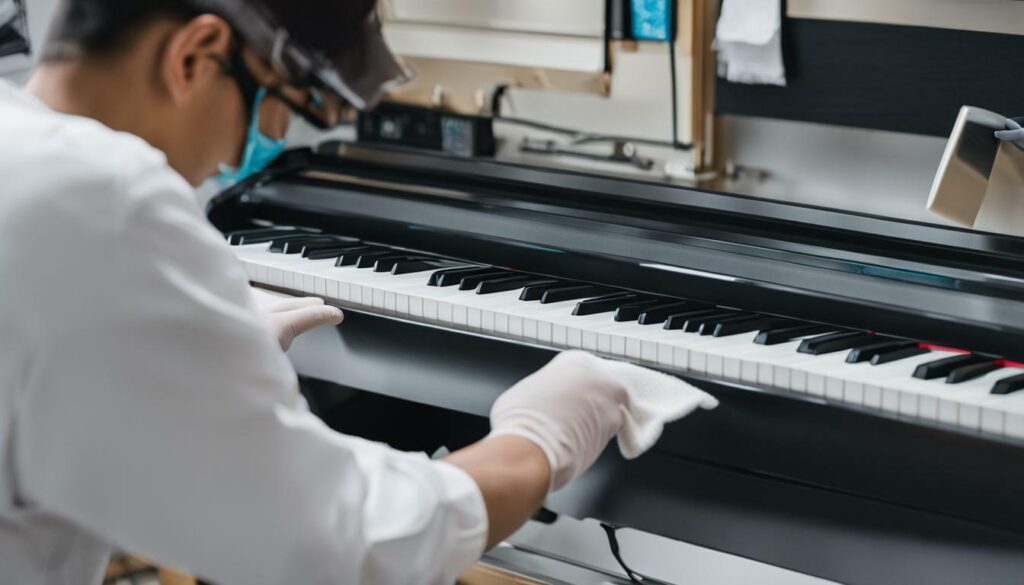
| Key Cleaning Tips: | Do’s | Don’ts |
|---|---|---|
| Use a feather duster or soft microfiber cloth to remove dust and debris from the keys. | Use a lukewarm water solution with a small amount of dishwashing liquid to gently clean the keys. | Use harsh cleaning products like bleach or alcohol. |
| Wipe each key with a damp cloth to remove any soap residue. | Gently dry the keys with a dry cloth to prevent moisture buildup. | Press too hard or use excessive force while cleaning. |
Proper storage for digital pianos
Proper storage is essential to maintain the condition of your digital piano. Whether you’re moving to a new home or simply need to store your instrument for a while, taking the necessary precautions can help protect it from potential damage. Here are some piano care tips to ensure your digital piano stays in optimal condition:
- Choose the right location: Avoid placing your digital piano in areas with extreme temperatures or high humidity. Exposure to moisture or heat can lead to electrical and mechanical problems. Find a cool, dry room with consistent temperature and humidity levels for storage.
- Use a dust cover: Dust and spills can harm the delicate components of your digital piano. Utilize a dust cover specifically designed for your instrument to keep it protected when not in use. This will help prevent dust buildup and accidental spills from causing damage.
- Avoid direct sunlight: Prolonged exposure to direct sunlight can cause fading and discoloration of the piano’s finish. Keep your digital piano away from windows or any other sources of direct sunlight to maintain its appearance.
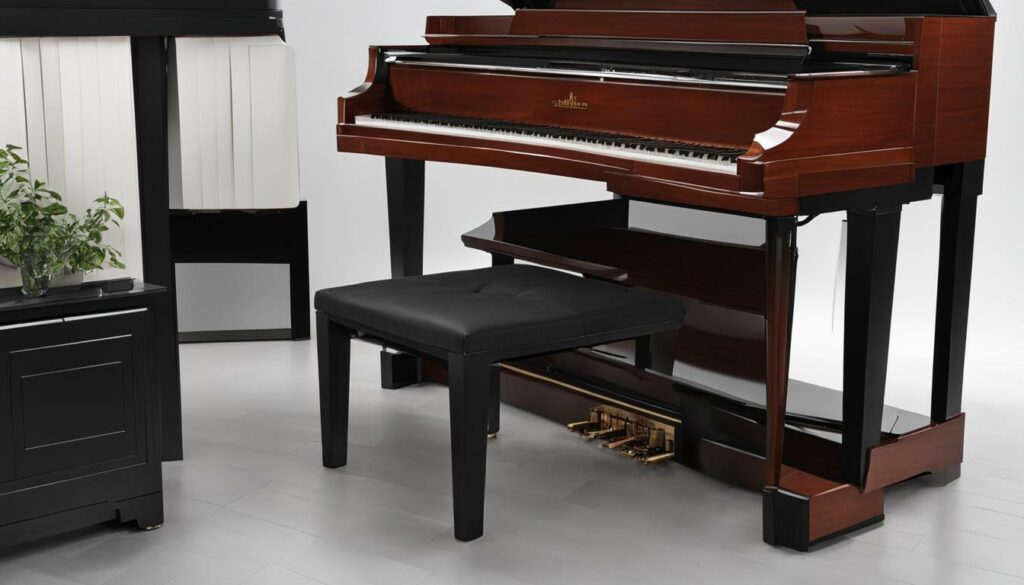
Proper storage is essential to maintain the condition of your digital piano.
Transportation and storage considerations
If you need to transport your digital piano or store it for an extended period, there are additional factors to consider:
- Protect the instrument: During transportation, use a padded case or specialized piano moving equipment to safeguard the instrument from bumps and jolts. If storing your digital piano for a long time, ensure it is stored securely to prevent it from shifting or falling.
- Temperature and humidity control: Extreme temperatures and humidity can cause irreversible damage to your digital piano. If you need to store your instrument in a location prone to these conditions, consider investing in climate-controlled storage to maintain a consistent environment.
- Regular maintenance: Before storing your digital piano, ensure it is clean and free from dust and debris. Follow the proper cleaning techniques mentioned earlier in this article to keep your instrument in pristine condition.
By following these piano care tips and taking the necessary steps for proper storage, you can help protect your digital piano from potential damage and ensure its longevity. Whether you’re an amateur musician or a professional performer, maintaining your instrument’s condition is essential for optimal playing experience and enjoyment.
Using the correct power supply
Using the correct power supply is vital for preserving the integrity of your digital piano. It is essential to refer to the manufacturer’s instructions to ensure you are using the appropriate power source. Connecting your digital piano to an incorrect power supply can lead to severe damage to the internal components, resulting in costly repairs or even rendering the instrument unusable.
To protect your digital piano and avoid any potential power-related issues, follow these tips:
- Use a power supply specifically designed for your digital piano model. Avoid using generic or incompatible adapters, as they may not provide the required voltage or amperage.
- Check the voltage and amperage specifications of your digital piano and match them with the power supply’s specifications.
- Ensure that the power outlet you are using is grounded and in good condition. Faulty or ungrounded outlets can pose a risk to both your instrument and your safety.
- Protect your piano from power surges by using a surge protector or an uninterrupted power supply (UPS). These devices can help regulate the power supply and prevent damage caused by electrical fluctuations.
By following these power supply guidelines, you can safeguard your digital piano from potential harm and enjoy its beautiful sound for years to come.
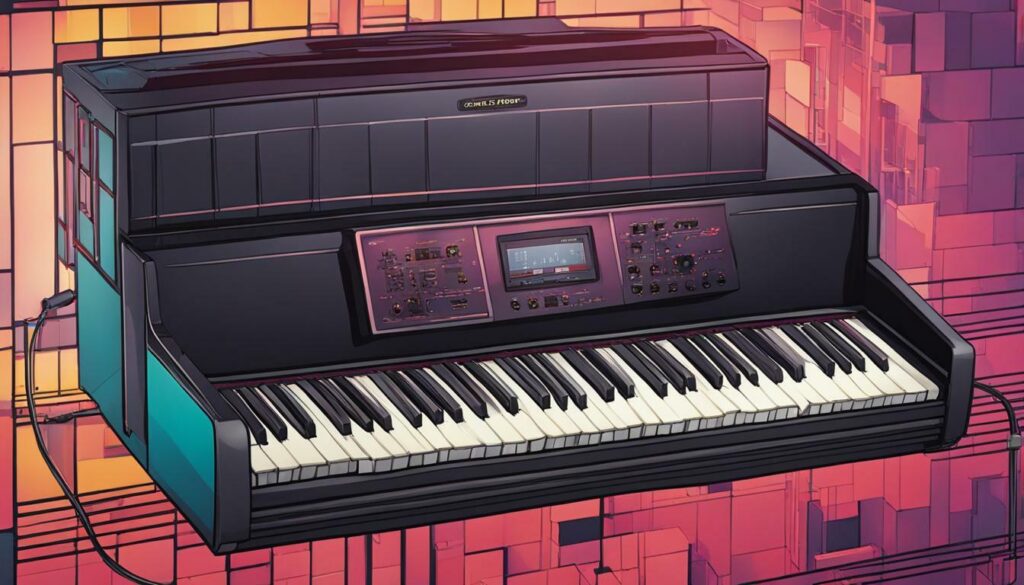
Note: Always consult the user manual or contact the manufacturer if you have any doubts or questions regarding the power supply requirements of your specific digital piano model.
Regular keyboard maintenance
Regular keyboard maintenance is essential for optimal performance and longevity. Proper care of the keys helps to ensure a smooth playing experience and prevents damage to the mechanisms. Here are some piano maintenance tips to keep your digital piano keys in top condition.
- Cleaning: To clean the keys, use a slightly damp cloth and a small amount of lukewarm water mixed with dishwashing liquid. Gently wipe down each key, taking care not to let excess moisture seep into the mechanisms. After cleaning, use a damp cloth to remove any soap residue and then dry the keys thoroughly with a soft cloth.
- Preventing Dust Buildup: Dust can accumulate on the keys and affect their responsiveness. Use a soft microfiber cloth or a feather duster to regularly remove dust from the surface of the keys. Avoid using cleaning products that contain bleach, alcohol, or other harsh substances, as they can damage the keys.
- Protective Measures: Using a keyboard cover or dust cover when the instrument is not in use can help protect the keys from dust, spills, and accidental damage. Ensure that the cover is made of a breathable material to prevent moisture buildup.
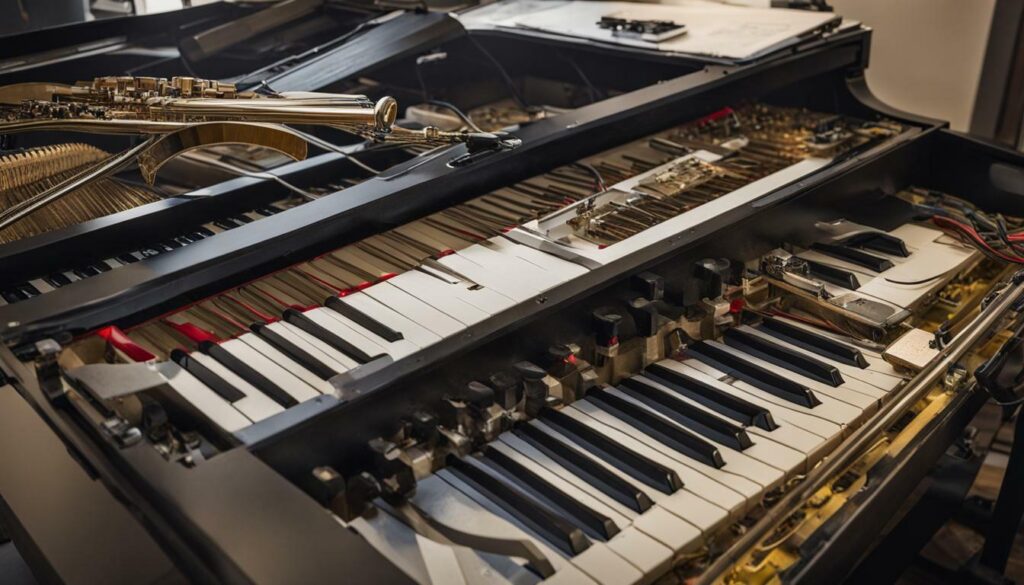
By following these simple maintenance tips, you can keep your digital piano keys clean, responsive, and in excellent condition for years to come. Remember to perform regular checks for loose connections and consult a professional if any repairs are needed. With proper care, your digital piano will continue to provide you with beautiful music and enjoyable playing experiences.
Checking for loose connections and dust buildup
Regularly inspecting your digital piano for loose connections and dust buildup is crucial to prevent potential damage. Over time, dust can accumulate in the internal components of the instrument, affecting its performance and longevity. Additionally, loose connections in the wiring can lead to malfunctioning keys or even electrical hazards. By following a few simple maintenance tips, you can ensure that your digital piano remains in optimal condition.
To start, gently remove any dust from the exterior of the piano using a feather duster or a soft microfiber cloth. This will help prevent dust particles from finding their way inside the instrument. Next, carefully open the piano and inspect the internal components for any visible dust buildup or loose connections.
If you notice any dust accumulation, use a soft brush or a can of compressed air to gently remove the debris. Be cautious not to apply too much force or use any liquid cleaners, as this may cause damage to the delicate circuitry inside the piano. Instead, rely on dry-cleaning methods to ensure the safety of your instrument.
| Key Tips for Checking Loose Connections and Dust Buildup: |
|---|
| 1. Regularly inspect the exterior and interior of your digital piano for dust accumulation and loose connections. |
| 2. Use a feather duster or a soft microfiber cloth to gently remove dust from the exterior surface. |
| 3. Carefully open the piano and use a soft brush or compressed air to remove dust from the internal components. |
| 4. Avoid using liquid cleaners or excessive force when cleaning the piano. |
| 5. If you encounter loose connections, consult a professional technician for repairs. |
By incorporating these simple maintenance practices into your routine, you can ensure that your digital piano remains in pristine condition, providing you with years of enjoyment and musical expression.
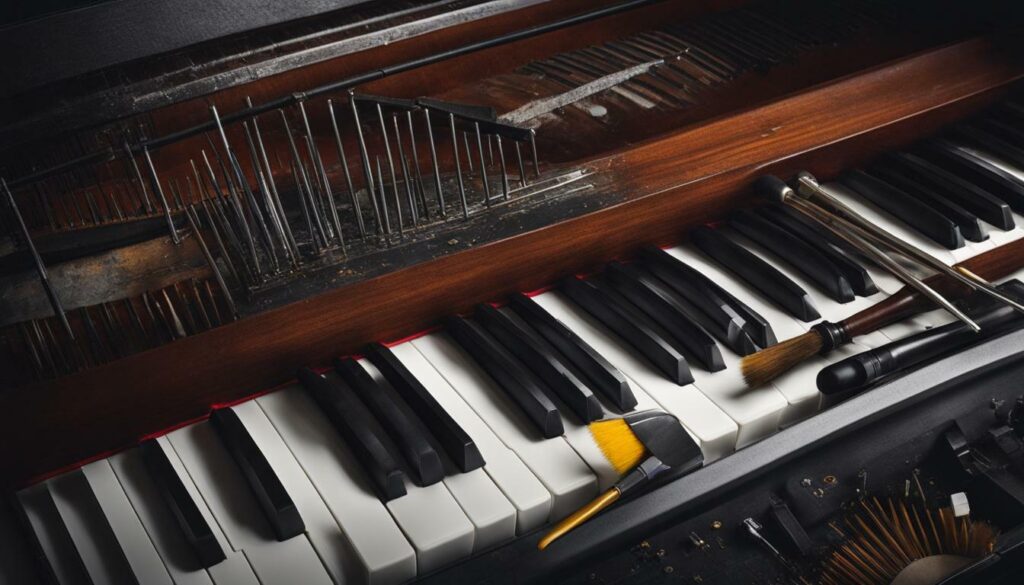
Proper transportation and storage methods are essential for protecting your digital piano from harm. Whether you’re moving to a new home or simply need to store your instrument for a period of time, following the right practices will help ensure its safety and longevity.
When transporting your digital piano, it’s important to handle it with care. Avoid any bumps or impacts that could damage the internal components. Use padded covers or cases specifically designed for digital pianos to provide additional protection. Secure the instrument properly in your vehicle to prevent it from shifting during transit.
When it comes to storing your digital piano, choose a location that is free from extreme temperatures and high humidity. These factors can negatively affect the electronic components of the piano. Avoid placing it near windows or areas with direct sunlight, as this can cause fading or warping of the finish.
Additionally, using a dust cover can help protect your instrument from dust accumulation and accidental spills. It’s important to clean the piano before storing it to prevent any dirt or debris from causing damage over time. Use a soft microfiber cloth or a feather duster to gently remove dust from the surface. If needed, you can use a mixture of mild soap and warm water to clean stubborn marks on the finish, but be sure to avoid using harsh chemicals or abrasive cleaners.
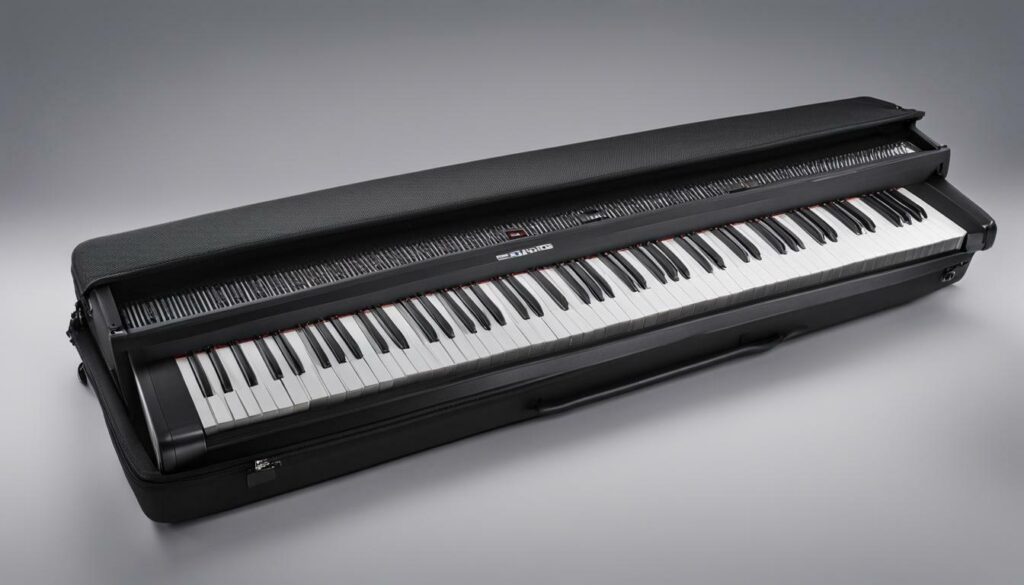
By taking these transportation and storage considerations into account, you can ensure that your digital piano remains in optimal condition. Protecting it from bumps, extreme temperatures, and humidity will help preserve its performance and functionality for years to come.
Transportation and Storage Guidelines:
| Transportation | Storage |
|---|---|
| Handle the piano with care and use padded covers or cases | Choose a location with stable temperatures and low humidity |
| Secure the instrument properly in your vehicle | Avoid placing the piano near windows or areas with direct sunlight |
| Avoid any bumps or impacts during transit | Use a dust cover to protect from dust accumulation and spills |
| Clean the piano before storage using a soft cloth or feather duster |
Source: Piano Care Experts
Conclusion
Taking proper care of your digital piano is crucial for maintaining its performance and longevity. By following a few simple maintenance practices, you can ensure that your instrument stays in pristine condition for years to come.
First and foremost, it’s important to clean your digital piano regularly to prevent the build-up of dust and dirt. Using a feather duster or a soft microfiber cloth, gently dust off the piano before proceeding with any cleaning. Avoid using cleaning products with bleach, alcohol, or other harsh substances, as they can damage the piano’s finish.
When it comes to cleaning the finish, a damp microfiber cloth is your best friend. If there are stubborn marks, a mixture of soap liquid and warm water can be used. Remember to wring out the cloth well before wiping down the piano, and always dry it thoroughly afterward to prevent any moisture damage.
Cleaning the keys requires extra caution, as using the wrong cleaning product can damage the mechanisms. To clean the keys, it’s best to use lukewarm water with a small amount of dishwashing liquid. Gently wipe down the keys with a damp cloth, making sure to remove any excess water afterward. Finish off by drying the keys with a soft, dry cloth to prevent any moisture from seeping into the mechanisms.
Proper storage is also essential for protecting your digital piano. Avoid storing it in areas with extreme temperatures or high humidity, as these conditions can cause irreversible damage. Using a dust cover can provide an added layer of protection against dust and spills.
Furthermore, using the correct power supply is vital to prevent any internal component damage. Always refer to the manufacturer’s instructions to ensure that you’re using the appropriate power supply for your digital piano.
Regular keyboard maintenance is another important aspect of caring for your digital piano. Clean the keys with a slightly damp cloth and ensure they’re dried thoroughly to keep them in good condition. Additionally, periodically check for loose connections and dust buildup, and if needed, consult a professional for any necessary repairs.
When it comes to transportation and storage, take precautions to protect your digital piano from bumps, extreme temperatures, and humidity. Safely secure it to avoid any accidental damage, and consider investing in a protective case if you frequently travel with your instrument.
By incorporating these maintenance tips into your routine, you can preserve the performance and longevity of your digital piano. With a little care and attention, your instrument will continue to bring you joy and inspiration for years to come.






